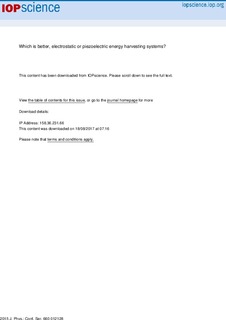Which is better, electrostatic or piezoelectric energy harvesting systems?
Journal article, Peer reviewed
Published version
Permanent lenke
http://hdl.handle.net/11250/2453672Utgivelsesdato
2015Metadata
Vis full innførselSamlinger
- Institutt for mikrosystemer [520]
- Publikasjoner fra CRIStin [3401]
Sammendrag
This paper answers the often asked, and until now inadequately answered, question of which MEMS compatible transducer type achieves the best power density in an energy harvesting system. This question is usually poorly answered because of the number of variables which must be taken into account and the multi-domain nature of the modelling and optimisation. The work here includes models of the mechanics, transducer and the power processing circuits (e.g. rectification and battery management) which in turn include detailed semiconductor models. It is shown that electrostatic harvesters perform better than piezoelectric harvesters at low accelerations, due to lower energy losses, and the reverse is generally true at high accelerations. At very high accelerations using MEMS-scale devices the dielectric breakdown limit in piezoelectric energy harvesters severely decreases their performance thus electrostatics are again preferred. Using the insights gained in this comparison, the optimal transduction mechanism can be chosen as a function of harvesting operating frequency, acceleration and device size.

